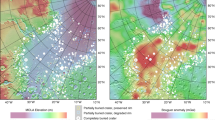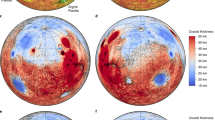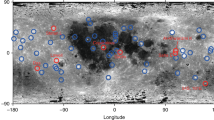Abstract
Mars is divided into two fundamentally different geological provinces of approximately hemispherical extent1–3. The more southerly province is heavily cratered, contains relatively old geological units, and superficially resembles the lunar and mercurian highlands. The northern province is relatively lightly cratered and contains younger geological units, including extensive plains, volcanic edifices, and volcanic calderas. Except for the Tharsis and Elysium regions and other large volcanoes, most of the younger, northern province consists of lowlands, which lie an average of 3 km below the highlands. Lowlands occupy about one-third of Mars. They are separated from the highlands by a distinct scarp or by a sloping transitional zone as much as 700km wide in which highland materials have been disrupted and partly replaced by lowland deposits (Fig. 1). The transition is characterized by a variety of landforms unknown on other planets. The highlands and lowlands are in isostatic equilibrium across the transitional zone4. No generally accepted explanation for the cause of the highland-lowland dichotomy has been proposed although thinning of the lithosph¨re in the northern hemisphere by internal processes has been suggested5. Large impacts, which were a feature of early Solar System history, have also been suggested as an important cause of such early planetary-surface heterogeneities3,6,7. Subcircular lowlands such as Argyre, Chryse, Hellas, and Isidis Planitia and the plains south of Tharsis occupy previously recognized impact basins8–10. We propose here that the largest expanse of lowlands also results from formation of a large impact basin early in Mars' history that has profoundly shaped the planet's surface.
This is a preview of subscription content, access via your institution
Access options
Subscribe to this journal
Receive 51 print issues and online access
$199.00 per year
only $3.90 per issue
Buy this article
- Purchase on Springer Link
- Instant access to full article PDF
Prices may be subject to local taxes which are calculated during checkout
Similar content being viewed by others
References
Mutch, T. A., Arvidson, R. E., Head, J. W., Jones, K. L. & Saunders, R. S. The Geology of Mars, 56 (Princeton University Press, 1976).
Carr, M. H. The Surface of Mars, 65, 73 (Yale University Press, New Haven, 1981).
Hartmann, W. K. J. geophys. Res. 78, 4096–4116 (1973).
Janle, P. Moon Planets 28, 55–67 (1983).
Wise, D. U., Golombek, M. P. & McGill, G. E. J. geophys. Res. 84, 7934–7939 (1979).
Hartmann, W. K. Icarus 19, 550–575 (1973).
Frey, H. Icarus 32, 235–250 (1977).
Wilhelms, D. E. J. geophys. Res. 78, 4084–4095 (1973).
Schultz, P. H., Schultz, R. A. & Rogers, J. J. geophys. Res. 87, 9803–9820 (1982).
Schultz, P. H. & Glicken, H. J. geophys. Res. 84, 8033–8047 (1979).
Schultz, P. H. Moon Morphology, 306 (University of Texas Press, Austin, 1976).
Stuart-Alexander, D. E. U.S. Geol. Surv. Map I-1047 (1978).
Wilhelms, D. E., Howard, K. A. & Wilshire, H. G. U.S. Geol. Surv. Map I-1162 (1979).
Cadogan, P. H. Nature 250, 315–316 (1974).
Whitaker, E. A. Geochim. cosmochim. Acta Suppl. 15, 105–111 (1981).
Wilhelms, D. E. NASA TM 85127, 111–113 (1982); Lunar planet. Sci. 14, 845–846 (1983).
Baldwin, R. B. The Measure of the Moon, 166 (University of Chicago Press, 1963).
Head, J. W., Settle, M. & Stein, R. S. Proc. 6th Lunar Sci. Conf. 2805–2829 (1975).
Pike, R. J. Icarus 43, 1–19 (1980).
Housen, K. R., Wilkening, L. L., Chapman, C. R. & Greenberg, R. Icarus 39, 317–351 (1979).
Gault, D. E. & Wedekind, J. A. in Impact and Explosion Cratering, 1231–1244 (Pergamon, New York, 1977).
Hartmann, W. K. & Davis, D. R. Icarus 24, 504–515 (1975); in Comets, Asteroids, Meteorites (ed. Delsemme, A.) 277–281 (University of Toledo Press, 1977).
Bowell, E., Gehrels, T. & Zellner, B. in Asteroids, 1111 (University of Arizona Press, Tucson, 1979).
Baldwin, R. B. Astr. J. 74, 570–571 (1969).
Howard, K. A., Wilhelms, D. E. & Scott, D. H. Rev. Geophys. Space Phys. 12, 309–327 (1974).
Wilhelms, D. E. Geologic History of the Moon (US Geol. Survey Prof. Pap., in the press).
Taylor, S. R. Planetary Science: A Lunar Perspective, 246 (Lunar and Planetary Institute, Houston, 1982).
Soderblom, L. A., Condit, C. D., West, R. A., Herman, B. M. & Kreidler, T. J. Icarus 22, 239–263 (1974).
Neukum, G. & Wise, D. U. Science 194, 1381–1387 (1976).
Hartmann, W. K. Icarus 31, 260–276 (1977).
Basaltic Volcanism Study Project Basaltic Volcanism on the Terrestrial Planets, 1075–1081 (Lunar and Planetary Institute, Houston, 1981).
Author information
Authors and Affiliations
Rights and permissions
About this article
Cite this article
Wilhelms, D., Squyres, S. The martian hemispheric dichotomy may be due to a giant impact. Nature 309, 138–140 (1984). https://doi.org/10.1038/309138a0
Received:
Accepted:
Issue Date:
DOI: https://doi.org/10.1038/309138a0
This article is cited by
-
Machine learning applied to simulations of collisions between rotating, differentiated planets
Computational Astrophysics and Cosmology (2020)
-
A thick crustal block revealed by reconstructions of early Mars highlands
Nature Geoscience (2020)
-
Decline of giant impacts on Mars by 4.48 billion years ago and an early opportunity for habitability
Nature Geoscience (2019)
-
Pre-mission InSights on the Interior of Mars
Space Science Reviews (2019)
Comments
By submitting a comment you agree to abide by our Terms and Community Guidelines. If you find something abusive or that does not comply with our terms or guidelines please flag it as inappropriate.



